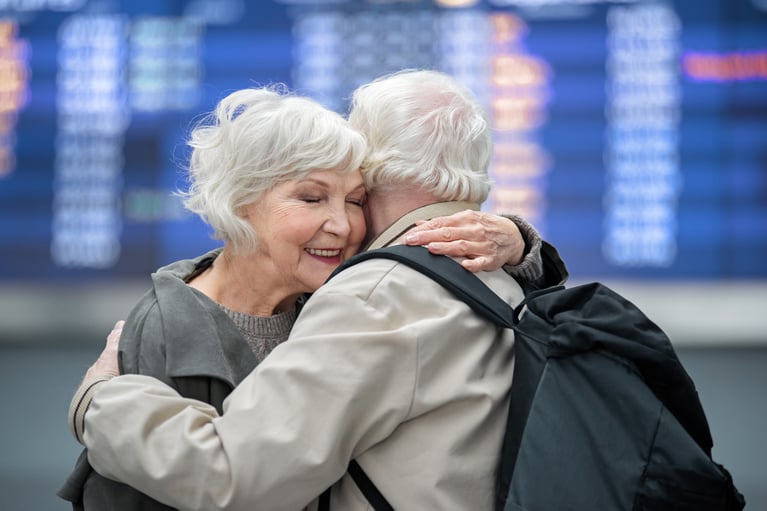6 min read
Mission Moment: Providing Hospice Patients the Opportunity to Travel
By: Angela Gruebbel on 9/16/19 10:34 PM


A grandchild’s wedding. A second honeymoon. One last trip to your favorite vacation spot. These are all moments that we want… and that our patients and their families deserve. Through a little coordination, hospices are uniquely positioned to make these moments happen.
The RegulationsThe Medicare Conditions of Participation (the “CoPs”) for hospice allow hospices to contract with other providers for services related to the patient’s terminal diagnosis.[1] Additionally, the CoPs allow hospices to contract for core services during temporary travel of a patient outside the hospice’s service area.[2] This is accomplished through a contract between the home hospice and the travel hospice for the provision of services to the patient, as needed.
Patient Materials
To set patients and families up for success, the patient handbook and other guidelines should address timely notification to the hospice of travel plans. These materials should specify that, whenever the patient travels, the patient should take his or her advance directives, medications and supplies on the trip. They should also instruct patients and families to continue calling the hospice for all needs while traveling.
Policies, Procedures and Best Practices
The hospice should have policies, procedures and/or best practices outlining processes for patients who travel. At a minimum, these should touch on care coordination and contracts and should delineate the staff responsible for associated tasks.
The IDG
The patient’s Interdisciplinary Group (the “IDG”) is responsible for updating the patient’s Plan of Care to reflect the patient’s needs and desires with respect the patient’s upcoming trip. The patient’s attending physician, if any, should be notified, and any need for routine visits, medication, equipment and supplies during the trip should be anticipated and planned for. The IDG should encourage the patient to take his or her advance directives, medications and supplies on the trip, and to continue calling the home hospice for any needs during travel.
It is up to the individual hospice to weigh the consequences of longer periods of travel and communicate those to the patient and family. If the patient plans to be out of the service area when he or she is scheduled for the comprehensive reassessment visit, which must occur no less frequently than every 15 days[3], the home hospice must request that the travel hospice perform the reassessment visit. In addition, the home hospice must consider if the patient needs routine nursing or aide visits to meet needs and visit frequencies as outlined in the plan of care. These decisions should be made on a case-by-case basis with the specific patient’s conditions and needs in mind.
1. 42 C.F.R.§418.100(e)
2. 42 C.F.R. §418.64
3. 42 C.F.R. §418.54(d)

The Travel Patient Agreement
In addition to addressing the language required by the CoPs, the travel patient agreement should cover, at a minimum, the following topics:
- Communication and coordination of care;
- Documentation and provision of information;
- Confidentiality;
- Reimbursement;
- Term and termination;
- Insurance and indemnification; and
- Any specific goods or services to be furnished.
With respect to item (g) above, if the home hospice knows it will be necessary for certain visits to be made or for certain goods, such as equipment, to be provided, these should be specifically addressed in the agreement. Travel patient agreements should be signed, dated and retained in accordance with the hospice’s records retention policies.
The Art (Also Known as the Heart)
Up to this point, I have discussed the technical aspects of patient travel – care coordination, policies, contracts, etc. However, there is also an art to working within these technical guardrails to improve patient experience. As someone who has developed travel patient arrangements for years, one of the best pieces of advice I can impart is this: find ways to make these arrangements work. There will be times when we hear from a patient at the last minute – sometimes even after they have arrived at their destination! – that they are taking a trip. There will be times when a family is driving across states and requires travel contracts for each city in which they plan to stay overnight. These are a lot of work, but they can also be some of the most rewarding challenges we face.

I once assisted a family with who wanted to spend a week at the beach with their son, who was a very young man. His condition necessitated use of a hospital bed with a veil to keep him safe while he slept. The travel hospice was able to provide the bed, but not the veil. So, in addition to the travel contract, I had to identify a DME provider willing to work with an out-of-state hospice. Fortunately, I was able to locate one, but being a few hours from the patient’s destination, the supplier had to arrange for the veil to be couriered to the condo. This trip required a unique level of coordination and attention to detail, as well as an unusual amount of expense. However, in the end, this family created cherished memories with their son and was very grateful for the efforts of all parties involved. This project taught me that with a little flexibility, you can make a family’s dreams come true while being a good steward of resources and minimizing risk to your organization.
Conclusion
Do you want to know more about coordinating patient travel arrangements? Members of Teleios Collaborative Network receive access to contract templates and other resources that can help your hospice take its travel patient processes to the next level. We would love to be a resource for you, too.

CPHRM, Chief Officer of Risk and Contract Management
Teleios University (TU)
Program Launch: January 20-21, 2020
Discover More

An organizational model that allows not-for-profit hospices (Members) to leverage best practices, achieve economies of scale and collaborate in ways that better prepare each agency to participate in emerging alternative payment models and advance their charitable missions.
Related Posts
Ring the Bell: How to implement the New Hospice Addendum!
Hospices are on the hook for all items, services, and drugs related to the patient’s prognosis....
The Hospice Medicare Carve-In
What the heck is a Carve-in?It is the opposite of what Hospice providers have enjoyed for the past...
The Hospice Medicare Carve-In, A good thing or bad thing?
What the heck is a Carve-in?



